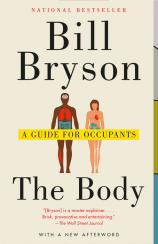The Body: A Guide for Occupants
Review
The Body: A Guide for Occupants
Bill Bryson is a very funny guy, as anyone who has dared to read his books like I’M A STRANGER HERE MYSELF or A WALK IN THE WOODS in a public place can attest. But in recent years, Bryson the humorist largely has given way to Bryson the polymath. With hefty volumes like A SHORT HISTORY OF NEARLY EVERYTHING and AT HOME: A Short History of Private Life, Bryson bravely has tackled some of science’s thorniest questions and has provided an intimate look at the places where we dwell.
Now, with THE BODY: A Guide for Occupants, Bryson has turned to a subject that should engage anyone who’s curious about the physical container that enables us to move through the world. It’s an informative, thought-provoking and at times amusing survey for the general reader of the wonder and occasional weirdness that is our physical life. Anyone who’s in reasonably good health and who’s fallen into the habit of taking that blissful state for granted would do well to consult Bryson’s book as a useful corrective.
THE BODY is a comprehensive tour of its subject --- from head to toe and from conception to death. In general, each chapter is devoted to a different system (with detours to consider vital subjects like food, sleep and disease), teeming with fascinating factoids, information gleaned from visits with eminent medical specialists (including time spent in a dissecting room), and ambles down the byways of medical and scientific history.
"...an informative, thought-provoking and at times amusing survey for the general reader of the wonder and occasional weirdness that is our physical life."
As Bryson points out, we “began our journey through history as unicellular blobs floating about in warm, shallow seas,” and he regards what’s happened since then as a “long and interesting accident, but a pretty glorious one, too.” One of the pleasures of THE BODY is that he never loses his sense of wonder for all that must go right to permit such fragile beings to move through the world each day with as little thought as we do. “The miracle of human life,” he points out, “is not that we are endowed with some frailties but that we aren’t swamped with them.”
Bryson is fond of dispensing data associated with the workings of the body that will allow you to fascinate your friends at some future gathering with much painlessly acquired arcane knowledge. You’ll learn, for example, that at this moment your body is home to 40,000 species of microbes, along with about 30 trillion human cells (37.2 trillion by one absurdly precise calculation). In your lifetime your heart will beat approximately 3.5 billion times, and you’ll breathe in and out 550 million times. Frighteningly, each year some two million Americans will acquire a serious infection while hospitalized, and 90,000 will die as a result.
As Bryson proceeds amiably but thoroughly through the body, he introduces the reader to many well-known and obscure figures in the history of medicine. (Do you know the origin of the word “stent,” or the reason why Bryson thinks Charles Scott Sherrington may “fairly be called the patriarch of the central nervous system?” The answers are here.) There are saints and scoundrels and more than one researcher who used himself as a human guinea pig, like Werner Forssmann, who received the Nobel Prize in Physiology and Medicine for discovering the cardiac catheter, awarded in 1956 despite his pro-Nazi activities.
One of the most compelling mini-biographies is that of Albert Schatz, who discovered streptomycin, the drug used to treat tuberculosis, once the second most frequent cause of death and now gone from the list of the top 10 causes. Schatz’s supervisor seized full credit for his work, a wrong that was only partially redressed through litigation. In 1993, Schatz received an award from the American Society for Microbiology, one named for his unethical supervisor.
Near the end of THE BODY, in a chapter entitled “Medicine Good and Bad,” Bryson steps outside the body to survey some of the stunning achievements of modern medical science, ones that resulted in the 20th century alone in improving life expectancy as much as in the whole of the preceding 8,000 years.
Yet at the same time, the Iowa-born British expatriate reminds his fellow Americans that for all those advances, when it comes to life expectancy, “it is not a good idea to be an American.” Despite spending two and a half times more per person than the average of all the other developed nations of the world ($3.2 trillion total), we come in 31st in global rankings of life expectancy --- just ahead of Cuba and Albania.
For all the curiosities and miracles we may experience over a lifetime that can stretch to nearly 10 decades, Bryson reminds us, we’re all destined to come to the same end, our bodies decomposing in a coffin over a period of between five and 40 years, or reduced by cremation to about five pounds of ashes. “And that’s you gone,” he writes. “But it was good while it lasted, wasn’t it?” While it lasts, THE BODY is very good indeed.
Reviewed by Harvey Freedenberg on November 1, 2019
The Body: A Guide for Occupants
- Publication Date: January 26, 2021
- Genres: Humor, Nonfiction, Science
- Paperback: 464 pages
- Publisher: Anchor
- ISBN-10: 0804172722
- ISBN-13: 9780804172721




